Abstract
Abstract: The green analytical procedure index (GAPI) has been widely used to assess the greenness of different steps in analytical methodology. In the GAPI index, the different stages of the chemical analysis process are depicted using five pentagrams divided in subsections, labeled green, yellow, or red according to the degree of greenness. This GAPI tool provides a quick overview of the environmental impact and safety of the procedure. However, there is no total score that can be calculated from the GAPI metric to enable comparison between methods. In this work, a modified GAPI tool (MoGAPI) and software have been developed and applied to address the limitations of the current GAPI metric. The presented tool offers a more precise assessment of greenness, while the software simplifies and expedites its application. It also combines the advantages of the analytical Eco-Scale with the merits of the widely used GAPI metric. This tool was successfully applied to calculate the greenness of a few case studies and applications to show the applicability of this modified metric. The software for the MoGAPI tool is also freely available (open source) at bit.ly/MoGAPI to facilitate application and method comparison. The MoGAPI tool and its software represent a significant advancement in greenness assessment, providing researchers with a robust and user-friendly means to evaluate and compare analytical methods.
1. Introduction
Green analytical chemistry (GAC) has emerged as a critical element in promoting sustainable development within quality control and analytical laboratories [1]. The 12 principles of GAC, derived from green chemistry principles, provide a framework for developing environmentally friendly analytical processes [2]. Such efforts typically involve utilizing cleaner, less harmful solvents or eliminating solvents altogether, minimizing reagent consumption, reducing energy utilization, avoiding derivatization, and limiting waste production [3,4,5]. Developing and implementing green metrics is crucial in comparing the sustainability of current and new analytical methods [6,7].
Several tools are currently utilized to estimate the environmental impacts of analytical processes. These metrics include the analytical Eco-Scale [8], green analytical procedure index (GAPI) [9], and AGREE metric [10], which are widely employed besides other tools and modifications such as ComplexGAPI [7] and AGREEprep [11,12], due to their ease of use and applicability to a wide range of analytical techniques, including UV-vis spectrophotometry [13,14], spectrofluorometry [15,16], chromatography [17,18,19], and others. According to the Scopus database, the most commonly cited evaluation tools are the analytical Eco-Scale and GAPI, with 937 and 570 documents, respectively.
The analytical Eco-Scale assigns a score out of 100 based on several factors, including the nature and quantity of solvents and reagents used, energy consumption, occupational hazards, and waste generation and management [15]. However, it does not consider the severity or hazardous nature of pictograms when assigning hazard penalty points to chemicals. Additionally, it is not yet possible to obtain analytical Eco-Scale results using an online tool. It lacks the visual impact of the GAPI and the AGREE metric. Despite these limitations, the analytical Eco-Scale remains a valuable tool for providing quantitative information about the environmental impact of analytical procedures.
The green analytical procedure index (GAPI) evaluates the environmental hazards of the entire analytical methodology using five colored pentagrams for the different steps involved in the analytical methodology. Each pentagram assesses specific aspects of the methodology: sampling, type of method, sample preparation, solvents/reagents used, and energy consumption. The GAPI tool provides a quick and fast overview of the greenness of different steps of the analytical methodology, making it useful for evaluating and optimizing analytical methodologies to reduce environmental effects [3,14,20]. However, the GAPI tool does not provide a total score for each procedure to facilitate comparison between methods. This point is the main drawback related to its use, and it may be a possible element that could further limit the diffusion of this tool.
This work aims to introduce a modified GAPI (MoGAPI) tool and software that merges the advantages of the visual impact of GAPI with the precise total score of the analytical Eco-Scale. The software was applied to calculate the greenness of selected analytical methods.
2. Assessment of the Method Greenness
To evaluate method greenness, the MoGAPI tool and software were developed and applied. The tool not only provides the characteristic red/green/yellow pictograms of the commonly used GAPI tool but also provides an overall assessment of the method greenness by calculating a total score. The score is calculated based on the number of options available in each item. For example, there are three choices in sample collection: in-line, online, or offline. The maximum score is given to in-line collection (3 credits), while the minimum score is attributed to offline collection (1 credit). The total credits are then summed and divided by maximum possible credits to calculate the percentage score. If the question is not applicable, it will be excluded from the total score in order not to affect the percentage. For example, if there is no extraction during sample preparation, then the “not applicable” option should be selected, and the method in this case can still obtain 100% if the other green criteria are fulfilled. The detailed scoring system is detailed in Table 1.

Table 1.
Points system of the proposed MoGAPI (modified with permission from [7]).
This pictogram evolution enables the GAPI tool to give an overall assessment of the greenness of analytical methods, instead of just evaluating each step separately. It also allows for more accurate and objective comparison between methods. Figure 1 shows four different methods assessed using the presented MoGAPI tool. The four methods exhibited a total score of 70, although each method has different green characteristics. Comparing these methods without a total score assigned to each method, depending on the entire analytical process, is not easy. For example, Method I has moderate greenness, as indicated by the multiple yellow sections. However, it is hard to compare Method I with Method II, which has more green sections, but at the same time, it has more red sections. This problem is more pronounced with Method III and Method IV. The proposed and developed evolution in the currently used GAPI scale not only allows comparison between these methods but also helps classify methods into excellent green (≥75), acceptable green (50–74), and inadequately green (<50), similar to the score used in the analytical Eco-Scale. The total score in this MoGAPI assessment appears on the chart, and the color of the scale around the pentagrams indicates the overall evaluation of the method. The software used to calculate the score and to generate the MoGAPI assessment is freely available (open source) at bit.ly/MoGAPI. It should be noted that a similar modification has been recently applied to ComplexGAPI to assign a total score, and an overall evaluation of analytical methods with pre-analytical procedures [21].
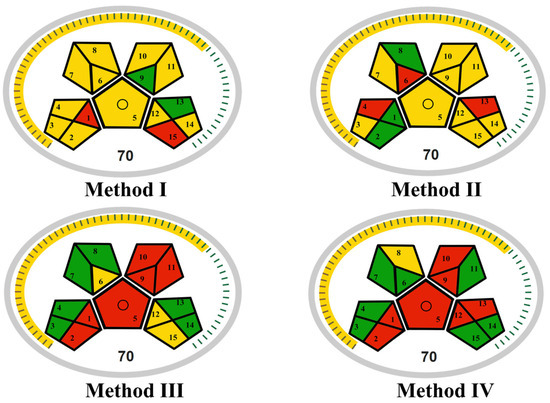
Figure 1.
MoGAPI scores of four methods, all having the same total score (70).
3. Case Studies
In the first application, a mixture of chloroform and dodecanol (30:70, v:v) was used for the dispersive liquid–liquid microextraction of four antiviral agents in environmental water, before analysis by HPLC-UV [22]. The stationary phase was a typical Hypersil ODS C18 column and the mobile phase consisted of ACN:phosphate buffer (50 mM, pH 6) (50:50, v:v). The samples were collected offline, with no preservation nor transportation required, stored under normal conditions, and microextracted using non-green solvent, without any additional treatment, with less than 10 mL of toxic solvent. The energy required for the instrument is ≤1.5 kWh per sample, with hermetic sealing and 1–10 mL waste per sample. As shown in Figure 2a, the total score is 70, which renders the method intermediate in greenness. The score was compared with the calculated greenness of the same method using the AGREE metric. As shown in Figure 2b, comparable results were obtained. It is worth mentioning that the two metrics do not have to give the same exact scores, but they should lead to the same conclusions.
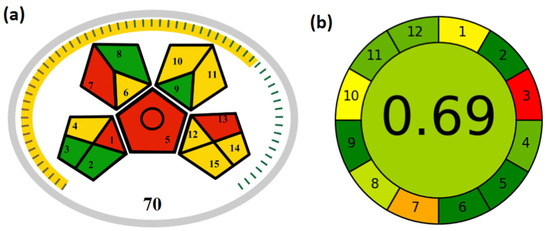
Figure 2.
MoGAPI (a) and AGREE (b) assessment scores for the reported method used for the determination of antivirals in environmental water.
In the second application, an ultrasound-assisted dispersive liquid–liquid microextraction was applied for the preconcentration of three gliflozins in deproteinized human plasma [23]. The extract was then determined using HPLC-DAD employing a C18 column and a mobile phase consisting of ACN:0.1% TFA pH 2.5, (40:60, v:v). The maximum enrichment was attained using dodecanol as an extractant. The samples were collected offline, with no preservation nor transportation required, stored under normal conditions, and microextracted using a green solvent, without any additional treatment, with less than 10 mL toxic solvent with no special hazards. The energy required for the instrument is ≤1.5 kWh per sample, with hermetic sealing and waste in the range 1 to 10 mL. As depicted in Figure 3a, the method has a total score of 80, which makes it overall green. A similar score was obtained when the method was assessed using AGREE (Figure 3b).
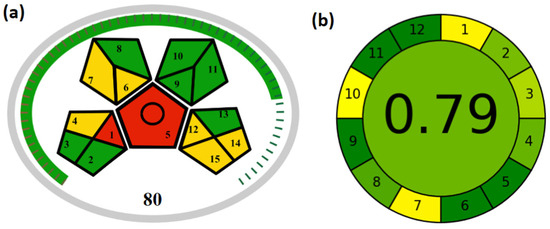
Figure 3.
MoGAPI (a) and AGREE (b) assessment scores for the reported method used for the determination of antidiabetics in plasma.
In the third application, a C18 column was dynamically modified using sodium dodecyl sulfate to introduce anionic functional groups on the surface of the column, thus enabling size exclusion of negatively charged analytes such as short-chain carboxylic acids in fruit juice and soft drink [24]. The analytes were separated using 1.84 mM sulfuric acid at pH 2.43 in less than 4 min. The samples were collected offline and stored under normal conditions, with no need for preservation or transportation. No microextraction or additional treatment was required. Less than 10 mL of low-toxicity solvents, with no special hazards, were used. The instrument required ≤1.5 kWh of energy per sample, and the process generated 1 to 10 mL of waste, all contained with hermetic sealing. The total score shown in Figure 4a was 79, which indicates the method’s greenness. The AGREE assessment gave a total score of 80, which leads to the same conclusion (Figure 4b).
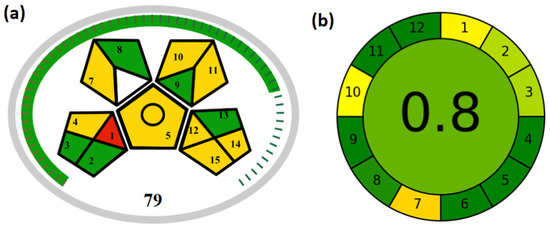
Figure 4.
MoGAPI (a) and AGREE (b) assessment scores for the reported method used for the determination of carboxylic acids in beverages.
The fourth application used a paper-based test strip designed for point-of-use quality testing of ethanol-based hand sanitizers [25]. The visual detection was dependent on complex formation between Fe3+ and methyl paraben in the presence of ethanol, where the latter is essential to dissolve methyl paraben. The samples were collected online, with no preservation, transportation, storage, or sample treatment required. Less than 10 mL of toxic solvents were employed with no special hazards. The energy required for the instrument is ≤1 kWh per sample, with hermetic sealing and waste less than 1 mL. The method had excellent greenness with a total score of 94 and 0.91 on MoGAPI and AGREE, respectively, as illustrated in Figure 5.
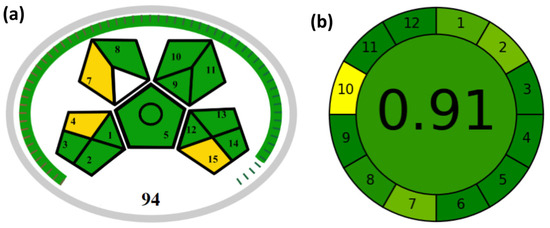
Figure 5.
MoGAPI (a) and AGREE (b) assessment scores for the reported method used for the determination of ethanol in hand sanitizers.
The reproducibility and reliability of the proposed score was assessed by evaluating the case studies by two independent experts and by comparing the scores obtained from MoGAPI with the scores obtained using AGREE. Statistical analysis was performed using Student’s t-test and F test. As indicated in Table 2, no significant differences between the metrics were observed, as indicated by the high p-values in both statistical tests at 95% significance levels.

Table 2.
Statistical comparisons between the proposed MOGAI metric and AGREE using Student’s t-test and F test.
4. Conclusions
A MoGAPI tool has been developed and successfully applied to assess the greenness of four reported methods. This modification of GAPI enables us to provide a visual overview of the environmental impact and safety of the method, while assigning a total score to each method. The case studies presented in this work demonstrate the practical utility and effectiveness of the MoGAPI tool in various analytical applications. The consistent results obtained using MoGAPI compared to other metrics like AGREE highlight its reliability and robustness in greenness assessment. In comparison to the analytical Eco-Scale, the MoGAPI offers a visual representation that provides insights into each step of the analysis process. Additionally, it can facilitate better comparisons between methods based on their total scores, particularly when the steps differ significantly. Moreover, the software facilitates faster and easier application of the MoGAPI. This MoGAPI tool provides a holistic assessment of method greenness, while the accompanying software makes application faster and easier. In future, the MoGAPI tool, supported by its user-friendly software, will undoubtedly serve as a valuable resource for researchers and practitioners aiming to develop and implement greener analytical methods. The continuous application and refinement of this tool will contribute to the broader goals of sustainability and environmental protection in analytical sciences. Applying this new metric to different analytical methods and techniques will be the focus of our future work.
Author Contributions
F.R.M. and J.P.-W. contributed to conceptualization; F.R.M. and M.L. contributed to investigation, project administration, resources, and supervision; all authors contributed writing—original draft and writing—review and editing. All authors have read and agreed to the published version of the manuscript.
Funding
This research received no external funding.
Institutional Review Board Statement
Not applicable.
Informed Consent Statement
Not applicable.
Data Availability Statement
Data will be made available on request.
Conflicts of Interest
The authors declare no conflicts of interest. The authors declare that they have no known competing financial interests or personal relationships that could have appeared to influence the work reported in this paper.
References
- Nowak, P.M.; Wietecha-Posłuszny, R.; Pawliszyn, J. White Analytical Chemistry: An Approach to Reconcile the Principles of Green Analytical Chemistry and Functionality. TrAC Trends Anal. Chem. 2021, 138, 116223. [Google Scholar] [CrossRef]
- Locatelli, M.; Kabir, A.; Perrucci, M.; Ulusoy, S.; Ulusoy, H.I.; Ali, I. Green Profile Tools: Current Status and Future Perspectives. Adv. Sample Prep. 2023, 6, 100068. [Google Scholar] [CrossRef]
- Kowtharapu, L.P.; Katari, N.K.; Muchakayala, S.K.; Marisetti, V.M. Green Metric Tools for Analytical Methods Assessment Critical Review, Case Studies and Crucify. TrAC Trends Anal. Chem. 2023, 166, 117196. [Google Scholar] [CrossRef]
- Saroj, S.; Shah, P.; Jairaj, V.; Rathod, R. Green Analytical Chemistry and Quality by Design: A Combined Approach towards Robust and Sustainable Modern Analysis. Curr. Anal. Chem. 2018, 14, 367–381. [Google Scholar] [CrossRef]
- Kokosa, J.M. Selecting an Extraction Solvent for a Greener Liquid Phase Microextraction (LPME) Mode-Based Analytical Method. TrAC Trends Anal. Chem. 2019, 118, 238–247. [Google Scholar] [CrossRef]
- Tobiszewski, M. Metrics for Green Analytical Chemistry. Anal. Methods 2016, 8, 2993–2999. [Google Scholar] [CrossRef]
- Płotka-Wasylka, J.; Wojnowski, W. Complementary Green Analytical Procedure Index (ComplexGAPI) and Software. Green Chem. 2021, 23, 8657–8665. [Google Scholar] [CrossRef]
- Gałuszka, A.; Migaszewski, Z.M.; Konieczka, P.; Namieśnik, J. Analytical Eco-Scale for Assessing the Greenness of Analytical Procedures. TrAC Trends Anal. Chem. 2012, 37, 61–72. [Google Scholar] [CrossRef]
- Płotka-Wasylka, J. A New Tool for the Evaluation of the Analytical Procedure: Green Analytical Procedure Index. Talanta 2018, 181, 204–209. [Google Scholar] [CrossRef]
- Pena-Pereira, F.; Wojnowski, W.; Tobiszewski, M. AGREE—Analytical GREEnness Metric Approach and Software. Anal. Chem. 2020, 92, 10076–10082. [Google Scholar] [CrossRef]
- Wojnowski, W.; Tobiszewski, M.; Pena-Pereira, F.; Psillakis, E. AGREEprep–Analytical Greenness Metric for Sample Preparation. TrAC Trends Anal. Chem. 2022, 149, 116553. [Google Scholar] [CrossRef]
- Sajid, M.; Płotka-Wasylka, J. Green Analytical Chemistry Metrics: A Review. Talanta 2022, 238, 123046. [Google Scholar] [CrossRef] [PubMed]
- Sharaf, Y.A.; Ibrahim, A.E.; El Deeb, S.; Sayed, R.A. Green Chemometric Determination of Cefotaxime Sodium in the Presence of Its Degradation Impurities Using Different Multivariate Data Processing Tools; GAPI and AGREE Greenness Evaluation. Molecules 2023, 28, 2187. [Google Scholar] [CrossRef] [PubMed]
- Ali, H.M.; Hammad, S.F.; El-Malla, S.F. Green Spectrophotometric Methods for Determination of a Monosodium Glutamate in Different Matrices. Microchem. J. 2021, 169, 106622. [Google Scholar] [CrossRef]
- Magdy, G.; Abdel Hakiem, A.F.; Belal, F.; Abdel-Megied, A.M. Green One-Pot Synthesis of Nitrogen and Sulfur Co-Doped Carbon Quantum Dots as New Fluorescent Nanosensors for Determination of Salinomycin and Maduramicin in Food Samples. Food Chem. 2021, 343, 128539. [Google Scholar] [CrossRef]
- Megahed, S.M.; Habib, A.A.; Hammad, S.F.; Kamal, A.H. Experimental Design Approach for Development of Spectrofluorimetric Method for Determination of Favipiravir; a Potential Therapeutic Agent against COVID-19 Virus: Application to Spiked Human Plasma. Spectrochim. Acta Part A Mol. Biomol. Spectrosc. 2021, 249, 119241. [Google Scholar] [CrossRef]
- Haq, N.; Iqbal, M.; Alanazi, F.K.; Alsarra, I.A.; Shakeel, F. Applying Green Analytical Chemistry for Rapid Analysis of Drugs: Adding Health to Pharmaceutical Industry. Arab. J. Chem. 2017, 10, S777–S785. [Google Scholar] [CrossRef]
- Yabré, M.; Ferey, L.; Somé, T.I.; Mercier, O.; Gaudin, K. Green Reversed-Phase HPLC Development Strategy: Application to Artesunate and Amodiaquine Analysis. J. Sep. Sci. 2020, 43, 4390–4404. [Google Scholar] [CrossRef]
- Yabré, M.; Ferey, L.; Somé, I.T.; Gaudin, K. Greening Reversed-Phase Liquid Chromatography Methods Using Alternative Solvents for Pharmaceutical Analysis. Molecules 2018, 23, 1065. [Google Scholar] [CrossRef]
- Shi, M.; Zheng, X.; Zhang, N.; Guo, Y.; Liu, M.; Yin, L. Overview of Sixteen Green Analytical Chemistry Metrics for Evaluation of the Greenness of Analytical Methods. TrAC Trends Anal. Chem. 2023, 166, 117211. [Google Scholar] [CrossRef]
- Mansour, F.R.; Omer, K.M.; Płotka-Wasylka, J. A Total Scoring System and Software for Complex Modified GAPI (ComplexMoGAPI) Application in the Assessment of Method Greenness. Green Anal. Chem. 2024, 10, 100126. [Google Scholar] [CrossRef]
- Kannouma, R.E.; Hammad, M.A.; Kamal, A.H.; Mansour, F.R. A Dispersive Liquid–Liquid Microextraction Method Based on Solidification of Floating Organic Droplet for Determination of Antiviral Agents in Environmental Water Using HPLC/UV. Microchem. J. 2021, 171, 106790. [Google Scholar] [CrossRef]
- Mabrouk, M.M.; Soliman, S.M.; El-Agizy, H.M.; Mansour, F.R. Ultrasound-Assisted Dispersive Liquid–Liquid Microextraction for Determination of Three Gliflozins in Human Plasma by HPLC/DAD. J. Chromatogr. B 2020, 1136, 121932. [Google Scholar] [CrossRef]
- Fasciano, J.M.; Mansour, F.R.; Danielson, N.D. Ion-Exclusion High-Performance Liquid Chromatography of Aliphatic Organic Acids Using a Surfactant-Modified C18 Column. J. Chromatogr. Sci. 2016, 54, 958–970. [Google Scholar] [CrossRef] [PubMed]
- El-Hassanein, A.M.; Mansour, F.R.; Hammad, S.F.; Abdella, A.A. Simple Colorimetric Paper-Based Test Strip for Point-of-Use Quality Testing of Ethanol-Based Hand Sanitizers. RSC Adv. 2024, 14, 8188–8194. [Google Scholar] [CrossRef]
Disclaimer/Publisher’s Note: The statements, opinions and data contained in all publications are solely those of the individual author(s) and contributor(s) and not of MDPI and/or the editor(s). MDPI and/or the editor(s) disclaim responsibility for any injury to people or property resulting from any ideas, methods, instructions or products referred to in the content. |
© 2024 by the authors. Licensee MDPI, Basel, Switzerland. This article is an open access article distributed under the terms and conditions of the Creative Commons Attribution (CC BY) license (https://creativecommons.org/licenses/by/4.0/).